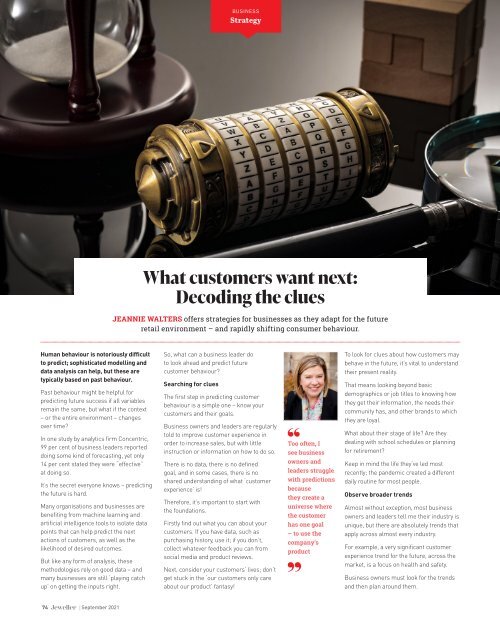Jeweller - September 2021
Create successful ePaper yourself
Turn your PDF publications into a flip-book with our unique Google optimized e-Paper software.
BUSINESS<br />
Strategy<br />
What customers want next:<br />
Decoding the clues<br />
JEANNIE WALTERS offers strategies for businesses as they adapt for the future<br />
retail environment – and rapidly shifting consumer behaviour.<br />
Human behaviour is notoriously difficult<br />
to predict; sophisticated modelling and<br />
data analysis can help, but these are<br />
typically based on past behaviour.<br />
Past behaviour might be helpful for<br />
predicting future success if all variables<br />
remain the same, but what if the context<br />
– or the entire environment – changes<br />
over time?<br />
In one study by analytics firm Concentric,<br />
99 per cent of business leaders reported<br />
doing some kind of forecasting, yet only<br />
14 per cent stated they were “effective”<br />
at doing so.<br />
It’s the secret everyone knows – predicting<br />
the future is hard.<br />
Many organisations and businesses are<br />
benefiting from machine learning and<br />
artificial intelligence tools to isolate data<br />
points that can help predict the next<br />
actions of customers, as well as the<br />
likelihood of desired outcomes.<br />
But like any form of analysis, these<br />
methodologies rely on good data – and<br />
many businesses are still ‘playing catch<br />
up’ on getting the inputs right.<br />
So, what can a business leader do<br />
to look ahead and predict future<br />
customer behaviour?<br />
Searching for clues<br />
The first step in predicting customer<br />
behaviour is a simple one – know your<br />
customers and their goals.<br />
Business owners and leaders are regularly<br />
told to improve customer experience in<br />
order to increase sales, but with little<br />
instruction or information on how to do so.<br />
There is no data, there is no defined<br />
goal, and in some cases, there is no<br />
shared understanding of what ‘customer<br />
experience’ is!<br />
Therefore, it’s important to start with<br />
the foundations.<br />
Firstly find out what you can about your<br />
customers. If you have data, such as<br />
purchasing history, use it; if you don’t,<br />
collect whatever feedback you can from<br />
social media and product reviews.<br />
Next, consider your customers’ lives; don’t<br />
get stuck in the ‘our customers only care<br />
about our product’ fantasy!<br />
Too often, I<br />
see business<br />
owners and<br />
leaders struggle<br />
with predictions<br />
because<br />
they create a<br />
universe where<br />
the customer<br />
has one goal<br />
– to use the<br />
company’s<br />
product<br />
To look for clues about how customers may<br />
behave in the future, it’s vital to understand<br />
their present reality.<br />
That means looking beyond basic<br />
demographics or job titles to knowing how<br />
they get their information, the needs their<br />
community has, and other brands to which<br />
they are loyal.<br />
What about their stage of life? Are they<br />
dealing with school schedules or planning<br />
for retirement?<br />
Keep in mind the life they’ve led most<br />
recently; the pandemic created a different<br />
daily routine for most people.<br />
Observe broader trends<br />
Almost without exception, most business<br />
owners and leaders tell me their industry is<br />
unique, but there are absolutely trends that<br />
apply across almost every industry.<br />
For example, a very significant customer<br />
experience trend for the future, across the<br />
market, is a focus on health and safety.<br />
Business owners must look for the trends<br />
and then plan around them.<br />
74 | <strong>September</strong> <strong>2021</strong>


















